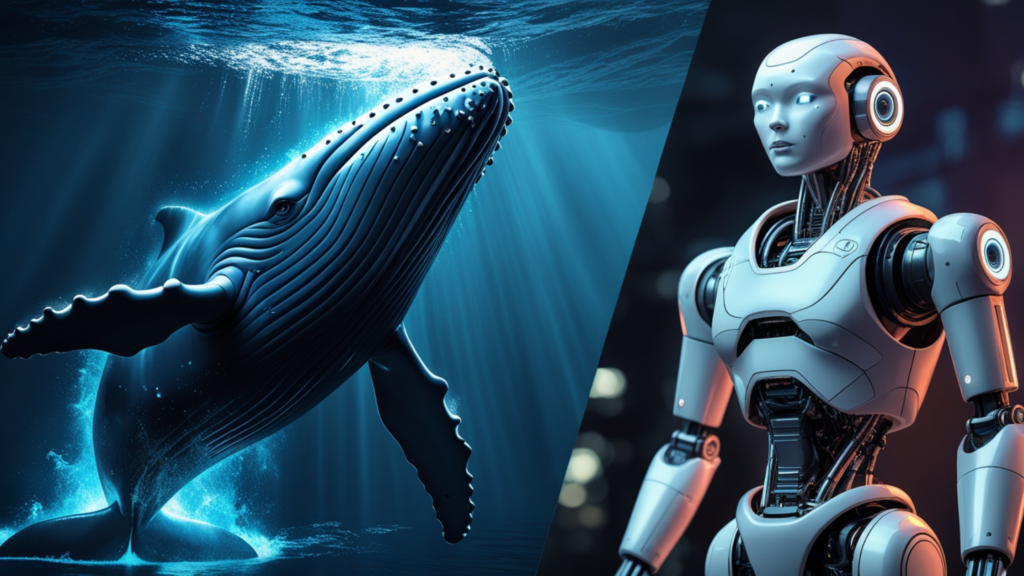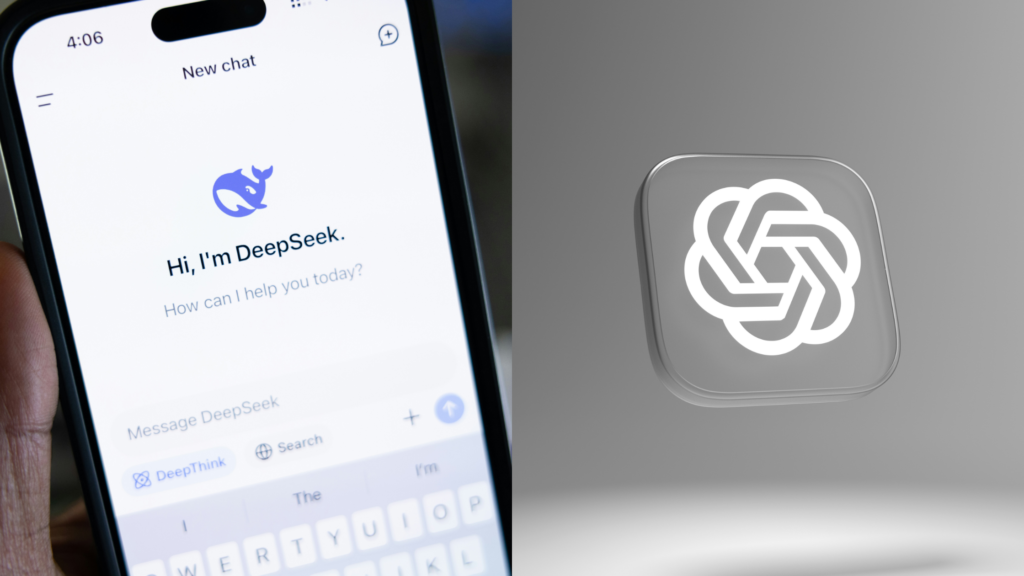DeepSeek AI vs ChatGPT: A Detailed 2025 Comparison

Artificial intelligence has become an essential part of everyday life, influencing everything from business automation to personal productivity. Among the many AI models available today, DeepSeek AI vs ChatGPT stand out as two powerful options. Both are designed to handle complex tasks, but their approaches, features, and capabilities differ.
If you’re wondering which one is the better fit for your needs, this in-depth guide will help. We’ll explore their architectures, features, strengths, and real-world applications. By the end, you’ll have a clear understanding of which AI model aligns best with your goals.
1. Understanding DeepSeek AI and ChatGPT
Before comparing the two models, it’s essential to understand their backgrounds, capabilities, and core objectives. Both DeepSeek AI and ChatGPT are large language models (LLMs), but they were developed by different organizations with distinct goals in mind.

1.1 What is DeepSeek AI?
DeepSeek AI is a large language model (LLM) developed by Highflyer, a Chinese artificial intelligence research company. The project emerged in 2023 as part of China’s effort to advance its AI technology following restrictions on AI chip sales imposed by the United States.
Unlike some commercial AI models, DeepSeek AI is designed for efficiency, affordability, and technical accuracy, making it an attractive choice for researchers, developers, and businesses looking for AI-driven solutions that balance cost and performance.
Core Objectives of DeepSeek AI
DeepSeek AI was built with several key priorities in mind:
- Providing an Open-Source Alternative – Many AI models, such as GPT-4, are proprietary and require payment. DeepSeek AI offers an open-source framework that allows businesses, developers, and academic researchers to modify and use the model freely.
- Enhancing Coding and Mathematical Reasoning – DeepSeek AI focuses on technical problem-solving, making it a strong tool for developers, engineers, and data scientists.
- Optimizing for Efficiency – The model is designed to use fewer computational resources, making it a cost-effective option for those looking to integrate AI without significant infrastructure investments.
- Flexible Deployment Options – Unlike cloud-dependent AI models, DeepSeek AI can be deployed locally or on private servers, giving businesses greater control over data privacy.
Key Features of DeepSeek AI
- Open-source and freely available – This makes it a practical choice for startups, academic institutions, and independent developers.
- Strong in coding and mathematics – It excels in structured problem-solving and is well-suited for algorithmic and numerical tasks.
- Lower operational costs – Due to its efficient architecture, it consumes fewer resources compared to other AI models.
- More customizable – Because it’s open-source, developers can fine-tune the model to meet their specific needs.
While DeepSeek AI is powerful in technical applications, it has some limitations in natural language conversations and creative writing, making it less effective for general-purpose chatbots or marketing copywriting.
1.2 What is ChatGPT?
ChatGPT is a conversational AI model developed by OpenAI, a leading research organization in the AI industry. The first version, GPT-3.5, was introduced in November 2022, followed by GPT-4, which offers enhanced accuracy, reasoning, and contextual understanding.
Unlike DeepSeek AI, which is primarily designed for efficiency and structured problem-solving, ChatGPT is built for versatility and user-friendliness. It can handle a broad range of language-based tasks, from writing and coding to business automation and customer support.
Core Objectives of ChatGPT
OpenAI developed ChatGPT with a focus on engagement, adaptability, and accessibility:
- Enhancing Natural Language Processing (NLP) – ChatGPT is optimized for human-like conversation, making it ideal for customer service, content creation, and virtual assistance.
- Providing Scalable AI Solutions – Available in multiple tiers, including a free GPT-3.5 version and a paid GPT-4 version, ChatGPT offers both accessibility and advanced features.
- Supporting Developers & Businesses – OpenAI has integrated ChatGPT into platforms like Microsoft Azure AI, GitHub Copilot, and ChatGPT Plus, making it widely usable in business applications.
- Continuous Improvement Through Updates – Unlike some static AI models, ChatGPT receives regular updates to improve its performance, accuracy, and ability to understand context.
Key Features of ChatGPT
- Conversational fluency – ChatGPT is one of the most human-like AI chat models, making it excellent for customer interactions and content creation.
- Multiple accessibility options – Users can access a free version (GPT-3.5) or upgrade to GPT-4 for more advanced capabilities.
- Integration with various applications – Works with Microsoft, GitHub, and business automation tools for easy implementation.
- Strong in creative writing and problem-solving – Can generate blog posts, ad copy, business strategies, and structured answers with ease.
ChatGPT is a well-rounded AI model, but it requires a subscription for advanced features and is cloud-dependent, meaning users must have an internet connection to access it.
1.3 Key Differences Between DeepSeek AI and ChatGPT
| Feature | DeepSeek AI | ChatGPT |
| Primary Focus | Technical accuracy, efficiency, and cost-effectiveness | Conversational fluency, versatility, and ease of use |
| Development Organization | Highflyer (China) | OpenAI (USA) |
| Open-Source | Yes – Free to modify and use | No – Proprietary software |
| Strengths | Coding, mathematical reasoning, and structured problem-solving | Natural conversation, creative writing, and general knowledge |
| Best for | Developers, researchers, startups, and businesses looking for budget-friendly AI | Content creators, businesses, marketers, and general users |
| Deployment Options | Local or cloud-based | Cloud-only |
| Customization | Can be fine-tuned | Limited customization |
| Pricing | Free and open-source | Free-tier (GPT-3.5) and paid-tier (GPT-4) |
1.4 Which AI Model is Right for You?
Choosing between DeepSeek AI and ChatGPT depends on your specific needs and how you plan to use AI. Here’s a quick guide to help you decide:
Choose DeepSeek AI if you need:
- A cost-effective, open-source AI with flexible deployment.
- AI support for coding, mathematical modeling, and structured tasks.
- An AI model that can be fine-tuned for specific business needs.
- A self-hosted solution that doesn’t rely on cloud-based AI.
Choose ChatGPT if you need:
- A conversational, user-friendly AI for writing, brainstorming, and customer interactions.
- Integration with existing business tools like Microsoft 365 and GitHub Copilot.
- A model that excels in creative, persuasive, and human-like writing.
- An AI chatbot for websites, apps, and customer support.
While both AI models have their advantages, the best choice depends on your specific use case. DeepSeek AI is an efficient, open-source tool for technical tasks, while ChatGPT is a highly adaptable, user-friendly AI for a broad range of applications.
2. Technical Comparison: DeepSeek AI vs. ChatGPT
Understanding the core technology behind each model is essential to evaluate their performance, efficiency, and suitability for different applications. While both models are powerful AI-driven tools, they use different architectures, training methodologies, and optimization techniques.

2.1 DeepSeek AI: Technical Overview
DeepSeek AI is built on a Mixture-of-Experts (MoE) architecture, a design that enhances efficiency by assigning different tasks to specialized components within the model. Unlike traditional transformer-based models, which process all inputs using the same set of weights, MoE dynamically activates only a subset of experts, making it more efficient in handling diverse tasks.
Core Technical Features of DeepSeek AI
Mixture-of-Experts (MoE) Architecture
- Instead of using a single large neural network for all tasks, DeepSeek AI has multiple smaller networks (experts) trained for specific types of problems.
- When processing a query, the model activates only the most relevant experts, reducing computational costs while maintaining high accuracy.
- This structure allows DeepSeek AI to scale efficiently without requiring the same level of hardware resources as traditional AI models.
Reinforcement Learning (RL) for Continuous Improvement
- The model refines its responses by using reinforcement learning algorithms, allowing it to adapt based on feedback and previous interactions.
- Unlike static models that generate outputs based purely on training data, DeepSeek AI learns dynamically, improving over time.
Retrieval-Augmented Generation (RAG) for Enhanced Accuracy
- One challenge with AI-generated content is hallucination, where a model generates incorrect or misleading information.
- DeepSeek AI incorporates RAG, which means it pulls in real-time information from external sources, improving factual accuracy.
- This makes it particularly useful for applications where up-to-date knowledge and precision are critical, such as scientific research, legal documents, and finance.
Optimized for Efficiency
- Unlike traditional AI models that require extensive computational power, DeepSeek AI is designed to use fewer resources while maintaining performance.
- It achieves this by activating only a fraction of its total model size for each task, reducing unnecessary computations.
- This efficiency makes it a cost-effective choice for businesses and developers looking to deploy AI without excessive cloud costs.
Flexible Deployment Options
- DeepSeek AI supports both cloud-based and local deployments, allowing businesses to host the model on their own infrastructure for better data security and privacy.
- This feature is particularly useful for organizations that handle sensitive information and require strict control over their AI operations.
Strengths and Limitations of DeepSeek AI
✅ Strengths:
✔️ Highly efficient and cost-effective.
✔️ Strong in coding, mathematics, and structured problem-solving.
✔️ Retrieval-augmented generation (RAG) reduces hallucination risks.
✔️ Open-source, allowing businesses to customize the model.
✔️ Can be deployed locally for better privacy.
❌ Limitations:
✖️ Less optimized for general conversational tasks compared to ChatGPT.
✖️ Weaker in creative writing and open-ended discussions.
✖️ Lacks the polish and fluency of human-like text generation.
2.2 ChatGPT: Technical Overview
ChatGPT is based on OpenAI’s transformer-based GPT (Generative Pre-trained Transformer) architecture, a neural network design that excels in natural language processing (NLP) and contextual understanding. Unlike DeepSeek AI, which prioritizes efficiency and technical accuracy, ChatGPT is designed for versatility, conversational fluency, and real-world applications.
Core Technical Features of ChatGPT
Transformer-Based GPT Architecture
- ChatGPT relies on self-attention mechanisms, which allow it to understand and generate coherent, context-aware responses.
- Unlike rule-based chatbots, it does not simply retrieve pre-written answers but creates responses dynamically, making interactions feel more human-like.
Two-Stage Training Process
ChatGPT is trained using two key phases:
- Pretraining Phase: The model is exposed to a massive dataset containing books, articles, and online content. This allows it to learn grammar, facts, and linguistic structures.
- Fine-Tuning with Reinforcement Learning from Human Feedback (RLHF): OpenAI refines the model by incorporating human feedback to improve response quality, reduce biases, and enhance conversational flow.
Self-Improvement Through RLHF (Reinforcement Learning from Human Feedback)
- ChatGPT continuously refines its responses based on user interactions and feedback.
- OpenAI monitors and updates the model regularly to correct errors, biases, and outdated information.
Context Retention for Natural Conversations
- One of ChatGPT’s strengths is its ability to remember context within a conversation, allowing for more natural, flowing discussions.
- Unlike some AI models that generate disjointed answers, ChatGPT can reference earlier parts of a conversation, making interactions feel more intuitive.
Integration with Business and Productivity Tools
- OpenAI has integrated ChatGPT with platforms like Microsoft Azure AI, GitHub Copilot, and business automation tools, making it highly adaptable for professional use.
- It is widely used in customer support, content creation, software development, and marketing.
Strengths and Limitations of ChatGPT
✅ Strengths:
✔️ Excels in natural conversation, writing, and idea generation.
✔️ Strong contextual memory, making it ideal for long discussions.
✔️ Well-suited for customer service, content creation, and business automation.
✔️ Regular updates ensure it stays current and accurate.
❌ Limitations:
✖️ Requires a cloud-based connection, unlike DeepSeek AI, which can run locally.
✖️ GPT-4 is a paid service, while DeepSeek AI is open-source.
✖️ Still prone to hallucinations, as it does not use real-time retrieval like DeepSeek AI’s RAG.
✖️ Less efficient for coding and numerical tasks compared to DeepSeek AI.
2.3 Side-by-Side Technical Comparison
| Feature | DeepSeek AI | ChatGPT |
| Core Architecture | Mixture-of-Experts (MoE) | Transformer-based GPT |
| Training Method | Pretrained with RAG and RL | Pretrained with RLHF |
| Focus Areas | Technical accuracy, coding, and efficiency | Conversational fluency, creativity, and user engagement |
| Computational Efficiency | High (uses only relevant experts per query) | Requires more computational resources |
| Factual Accuracy | Strong (Retrieval-Augmented Generation) | Moderate (Does not retrieve real-time data) |
| Customization | Open-source, can be fine-tuned | Limited customization |
| Deployment | Cloud and on-premises | Cloud-based only |
| Best Use Cases | Coding, mathematics, structured tasks | Content creation, chatbots, marketing, and automation |
2.4 Which Model is More Suitable for Your Needs?
- If you need an AI for coding, mathematical problem-solving, or localized deployments, DeepSeek AI is a better fit.
- If you’re looking for a conversational AI that can write, assist customers, and integrate into business workflows, ChatGPT is the stronger choice.
Both models have unique strengths, so choosing the right one depends on your specific needs.
Would you like to explore real-world use cases for each model? Let me know how I can refine this further!
3. Feature Comparison: DeepSeek AI vs. ChatGPT
Choosing the right AI model depends on understanding its capabilities, strengths, and limitations in real-world applications. While both DeepSeek AI and ChatGPT are powerful, they serve different purposes, making them more suitable for specific users and industries.

This section provides a detailed comparison across multiple features, including specialization, pricing, deployment options, data training focus, and performance in various use cases.
3.1 Core Capabilities: Side-by-Side Breakdown
| Feature | DeepSeek AI | ChatGPT |
| Primary Focus | Coding, problem-solving, and technical queries | Conversational AI, content creation, and business automation |
| Architecture | Mixture-of-Experts (MoE), optimized for efficiency | Transformer-based GPT, optimized for language fluency |
| Creativity | Limited—structured responses, better at logic-based tasks | Strong—excels in creative writing, storytelling, and content generation |
| Accuracy | High for structured and factual tasks (retrieves external data) | Good but prone to hallucination (relies on pre-trained knowledge) |
| Customization | Open-source, allows developers to modify and fine-tune | Closed-source, limited customization options |
| Deployment | Supports both online and local deployment for privacy-sensitive applications | Cloud-based only, requires an internet connection |
| Pricing Model | More affordable, with an open-source option | Premium plans available, GPT-4 requires payment |
| Training Focus | China-focused, integrates open-source datasets | Trained on a global dataset, making it more suitable for diverse content |
| Best For | Developers, data scientists, and businesses needing an efficient and cost-effective AI | Writers, marketers, and businesses needing engaging and human-like AI responses |
3.2 Performance Across Different Use Cases
While both models can be used for a variety of tasks, their strengths vary depending on the industry and application. Below is a breakdown of how each model performs in specific scenarios.
3.2.1 For Developers & Data Scientists
AI-powered assistants have become essential in coding, debugging, and data analysis. Here’s how both models compare:
✅ DeepSeek AI
- Optimized for coding-related tasks, especially in Python, JavaScript, and data science applications.
- Provides accurate, structured explanations for algorithms and technical queries.
- Uses Retrieval-Augmented Generation (RAG), improving factual accuracy for complex problem-solving.
- Can run locally, making it ideal for organizations with strict data privacy requirements.
❌ Limitations:
- Not as effective for general programming discussions that require conversational context.
- Struggles with open-ended creative problem-solving.
✅ ChatGPT
- Excels in explaining coding concepts in a clear and beginner-friendly manner.
- Provides more conversational interactions, making it better for interactive debugging.
- Useful for generating code snippets, refactoring, and suggesting improvements.
❌ Limitations:
- Less efficient for complex numerical computations.
- Lacks real-time data retrieval, increasing the risk of providing outdated information.
🔎 Verdict:
DeepSeek AI is better for technical accuracy, while ChatGPT is better for interactive learning and general programming discussions.
3.2.2 For Content Creators & Writers
When it comes to writing, brainstorming, and storytelling, AI can play a huge role in enhancing productivity. Here’s how both models compare:
✅ DeepSeek AI
- Better at generating structured content, such as research reports, outlines, and technical documents.
- Provides fact-based writing using its retrieval-augmented capabilities.
- Can generate SEO-optimized content with more factual accuracy.
❌ Limitations:
- Struggles with free-flowing creative writing, such as poetry and storytelling.
- Lacks a natural tone, making it less effective for conversational writing.
✅ ChatGPT
- Excels in creative writing, storytelling, and blog content.
- More engaging tone, making it better for brand messaging and marketing copy.
- Can adapt to different writing styles, from professional to casual.
❌ Limitations:
- May include fabricated facts since it does not retrieve real-time data.
- Less structured in technical and research-heavy writing.
🔎 Verdict:
ChatGPT is the stronger choice for creative writing, while DeepSeek AI is better for factual and structured content.
3.2.3 For Businesses & Marketers
Businesses use AI to enhance customer interactions, automate marketing, and improve content strategies. Here’s how DeepSeek AI and ChatGPT compare in a business setting:
✅ DeepSeek AI
- Works well for automated data analysis, helping businesses with trend analysis and forecasting.
- Can generate structured responses for customer queries.
- Supports local deployment, making it ideal for businesses handling sensitive customer data.
❌ Limitations:
- Lacks conversational fluency, making it less effective for customer-facing applications.
- Less adaptable for dynamic marketing strategies.
✅ ChatGPT
- Highly effective for chatbots, customer service, and engagement-driven content.
- Can personalize responses for better user experiences.
- Works well for social media content, ad copy, and branding strategies.
❌ Limitations:
- Cannot be deployed locally, which may be a concern for data privacy.
- Can generate inaccurate or misleading business insights without real-time data updates.
🔎 Verdict:
DeepSeek AI is better for business automation, while ChatGPT is ideal for customer engagement and marketing copy.
3.3 Which AI Model is Right for You?
The choice between DeepSeek AI and ChatGPT depends on your specific needs and priorities.
Choose DeepSeek AI If You:
✔️ Need an AI assistant for coding, technical problem-solving, or data analysis.
✔️ Require a cost-effective, open-source solution.
✔️ Want local deployment for privacy-sensitive applications.
✔️ Prefer fact-based, structured content over creative writing.
Choose ChatGPT If You:
✔️ Need an AI for content creation, customer service, or business automation.
✔️ Prefer an engaging, conversational experience.
✔️ Want a highly polished writing style for blogs, articles, or marketing.
✔️ Are comfortable with a cloud-based AI model.
4. Real-World Performance & Market Trends
Understanding how DeepSeek AI and ChatGPT perform in real-world applications is essential for businesses, developers, and general users. While technical benchmarks provide insight into raw capabilities, actual market adoption and user preferences often reveal deeper insights about each model’s strengths and weaknesses.

This section explores how users interact with both models, industry adoption trends, and comparative benchmarks that highlight their efficiency across different use cases.
4.1 User Preferences & Market Response
The adoption of AI models is influenced by cost, usability, flexibility, and integration capabilities. DeepSeek AI and ChatGPT have attracted different user bases, each with distinct priorities.
DeepSeek AI: Gaining Momentum in the Open-Source Community
DeepSeek AI has seen rapid adoption, particularly among developers, AI researchers, and enterprises looking for a cost-effective, customizable AI solution.
✔️ Topping Download Charts: In early 2025, DeepSeek AI became the most downloaded free app on Apple’s App Store. This reflects growing user interest in open-source AI solutions, especially among those seeking an alternative to commercial AI models.
✔️ Popular Among Developers & Enterprises: Many organizations prefer DeepSeek AI for its affordable API pricing and on-premise deployment capabilities, allowing businesses to use AI while maintaining data privacy and security.
✔️ Academic & Research Institutions Prefer Open-Source AI: Universities and AI research labs are integrating DeepSeek AI into their workflows due to its transparency, modifiability, and ability to run locally without vendor restrictions.
✔️ Expanding in Non-English Markets: DeepSeek AI has gained traction in Asia, Eastern Europe, and Latin America, where developers prefer localized AI models that can be fine-tuned for specific linguistic and cultural nuances.
ChatGPT: The AI Standard for Businesses & Content Creators
ChatGPT remains a dominant force in the AI market, particularly in business and creative industries where content generation, customer support, and marketing automation are critical.
✔️ Backed by Microsoft’s Ecosystem: ChatGPT benefits from its integration with Microsoft products like Word, Excel, and Teams, making it a natural choice for enterprises using these tools.
✔️ Preferred by Content Creators & Marketers: Many content-driven industries, including digital marketing, journalism, and e-commerce, rely on ChatGPT’s ability to generate human-like, engaging text quickly.
✔️ Widespread API Adoption: ChatGPT’s well-documented API has led to widespread adoption in SaaS platforms, chatbots, and virtual assistants, making it a core component of many business automation solutions.
✔️ Strong Brand Trust & Recognition: Since its launch, ChatGPT has maintained a high level of user trust, benefiting from OpenAI’s strong reputation in AI ethics and continuous model improvements.
🔎 Market Trend Insight: While DeepSeek AI is growing among developers and enterprises, ChatGPT continues to dominate among business professionals, writers, and general users due to its ease of use and broad integration with productivity tools.
4.2 Benchmark Comparisons: How Do They Stack Up?
| Category | DeepSeek AI | ChatGPT |
| Conversational Flow | More structured, optimized for factual queries | More natural, mimics human-like dialogue effectively |
| Content Generation | Logical and fact-based, but lacks creativity | Engaging and fluent, excellent for storytelling and marketing |
| Code Assistance | Excels in structured programming & debugging | Good for simple scripts but less reliable for debugging |
| Mathematical Reasoning | Strong accuracy in logic-based tasks | Decent, but sometimes makes calculation errors |
| Real-Time Data Access | Uses retrieval-augmented generation (RAG) for fact-checking | Relies on pre-trained knowledge, leading to occasional outdated responses |
| Customization & Fine-Tuning | Fully open-source, can be modified extensively | Limited customization outside API parameters |
| Privacy & Security | Can be deployed locally, offering better data control | Cloud-based only, requiring trust in OpenAI’s infrastructure |
| API Pricing | Lower-cost API, making it more affordable for startups | Higher cost, especially for GPT-4 access |
| Enterprise Integration | Limited third-party integrations | Seamless integration with Microsoft 365, Slack, Notion, and CRM platforms |
| Global Market Reach | Gaining traction in non-English markets | Widely adopted across business and consumer sectors |
Key Observations from Benchmark Data
✔️ DeepSeek AI is stronger in logical reasoning, coding, and fact-based retrieval, making it a preferred option for developers and research-heavy applications.
✔️ ChatGPT excels in fluid conversations, content creation, and business integrations, making it the go-to choice for marketers, writers, and enterprise automation.
✔️ DeepSeek AI is more cost-effective for businesses that want a low-cost, customizable AI model, whereas ChatGPT offers better third-party integrations for businesses looking for an out-of-the-box AI assistant.
✔️ Privacy-sensitive industries prefer DeepSeek AI because it can be hosted locally, while general users and enterprises lean toward ChatGPT for its ease of use and broad adoption.
What These Trends Mean for the Future
The AI landscape is evolving, with DeepSeek AI carving out a niche among technical users and ChatGPT maintaining its dominance in business and consumer AI.
🔹 DeepSeek AI is likely to expand in developer communities, privacy-sensitive industries, and research institutions, especially as open-source AI adoption increases.
🔹 ChatGPT will continue leading in marketing, automation, and enterprise AI solutions, particularly as Microsoft and OpenAI integrate AI deeper into workplace applications.
🔹 Hybrid AI solutions may emerge, where businesses leverage DeepSeek AI for internal problem-solving while using ChatGPT for customer interactions and creative work.
Both models have clear advantages, and the best choice depends on the specific needs of businesses and users.
5. Pros and Cons of Each Model
While both DeepSeek AI and ChatGPT are powerful AI models, they serve different purposes. Some users may prioritize accuracy and efficiency, while others may need creativity and conversational ability. To make an informed choice, it’s important to understand the key advantages and limitations of each model.

This section provides a detailed breakdown of the strengths and weaknesses of DeepSeek AI and ChatGPT based on real-world applications.
5.1 Pros & Cons of DeepSeek AI
DeepSeek AI is designed for structured problem-solving, making it a strong choice for developers, researchers, and professionals working with coding, data analysis, and logic-driven tasks.
✅ Pros of DeepSeek AI
✔️ Open-Source and Customizable
- One of the biggest advantages of DeepSeek AI is that it is open-source, meaning developers can modify, fine-tune, and deploy it on their own servers.
- This makes it ideal for organizations that require full control over AI deployment without relying on third-party services.
✔️ Excels in Coding, Math, and Structured Problem-Solving
- DeepSeek AI is highly optimized for technical queries, making it more reliable for coding, debugging, and data-related tasks.
- It supports programming languages like Python, JavaScript, and C++, offering precise, structured code outputs.
✔️ Supports Local Deployment for Privacy-Sensitive Applications
- Unlike ChatGPT, DeepSeek AI can be deployed locally, meaning businesses, researchers, and governments can use it without sending data to external servers.
- This is particularly useful for organizations handling sensitive information.
✔️ More Cost-Effective for Long-Term AI Use
- Since DeepSeek AI offers an open-source version, businesses can reduce long-term costs associated with AI subscriptions and API usage.
- It’s a great choice for companies that want to integrate AI without ongoing premium costs.
✔️ Better Fact-Checking with Retrieval-Augmented Generation (RAG)
- DeepSeek AI retrieves real-time data for fact-based queries, reducing the chances of misinformation.
- This makes it more reliable for research-heavy applications.
❌ Cons of DeepSeek AI
✖️ Limited Creativity and Conversational Abilities
- While DeepSeek AI is great for technical problem-solving, it struggles with free-flowing conversations and creative writing.
- It’s not ideal for storytelling, blog writing, or social media content.
✖️ Less Effective for Customer Engagement and Marketing
- Unlike ChatGPT, DeepSeek AI does not generate emotionally engaging content, making it less suitable for brand messaging, advertisements, and interactive customer support.
✖️ Requires Technical Knowledge for Customization
- Since it is an open-source model, users need programming skills to modify and deploy it effectively.
- Businesses without a strong technical team may struggle with setup and maintenance.
✖️ Fewer Third-Party Integrations
- DeepSeek AI has limited integrations with platforms like Slack, Zapier, and CRMs, which makes it harder to automate workflows compared to ChatGPT.
🔎 Verdict:
DeepSeek AI is an excellent choice for developers, researchers, and businesses focused on technical problem-solving and cost-effective AI deployment. However, it is not ideal for content creation, marketing, or customer engagement.
5.2 Pros & Cons of ChatGPT
ChatGPT is widely recognized for its human-like conversational abilities, making it one of the most versatile AI models for content creation, customer service, and marketing automation.
✅ Pros of ChatGPT
✔️ Excels in Conversational AI & Natural Language Understanding
- ChatGPT is designed to mimic human-like conversations, making it a great tool for chatbots, customer service, and virtual assistants.
- It can understand context, tone, and intent, providing more engaging and personalized responses.
✔️ Best for Content Creation & Marketing Copy
- Unlike DeepSeek AI, ChatGPT is highly effective for writing blogs, articles, and ad copy.
- It can generate SEO-friendly content, product descriptions, and social media posts with ease.
✔️ Strong API Support with Extensive Documentation
- ChatGPT provides well-documented API access, allowing businesses to integrate it into their workflows easily.
- It works well with platforms like Slack, Notion, and customer service tools.
✔️ Adapts to Different Writing Styles & Industries
- Whether you need a formal business tone, casual storytelling, or technical explanations, ChatGPT can adjust its writing style accordingly.
- This makes it useful across multiple industries, including healthcare, finance, and e-commerce.
✔️ Regular Model Updates & Improvements
- OpenAI continuously updates ChatGPT with new enhancements, improving accuracy, fluency, and response quality over time.
- The model evolves based on real-world usage and feedback.
✔️ User-Friendly & Accessible
- ChatGPT requires no technical expertise to use, making it ideal for business owners, content creators, and non-technical users.
- It has an easy-to-use web interface and mobile app for instant access.
❌ Cons of ChatGPT
✖️ Requires a Paid Subscription for Advanced Features
- While the free version is useful, GPT-4 and advanced API access require a subscription.
- Businesses with heavy AI usage may find costs adding up over time.
✖️ Lacks Real-Time Data Retrieval
- ChatGPT does not fetch real-time information and relies on pre-trained knowledge.
- This means it may provide outdated or incorrect information, especially in fast-changing industries like finance or technology.
✖️ Higher Risk of Hallucination (Fabricating Facts)
- Since ChatGPT does not verify facts from external sources, it sometimes generates confident but inaccurate statements.
- Users must manually fact-check AI-generated responses, especially for research-heavy topics.
✖️ Cloud-Based Only—No Local Deployment
- Unlike DeepSeek AI, ChatGPT cannot be installed or run locally.
- This means businesses dealing with sensitive data have limited control over privacy and security.
✖️ Less Effective in Code Optimization & Problem-Solving
- While ChatGPT can assist with programming, it lacks the precision of DeepSeek AI for complex debugging and structured coding tasks.
- It may suggest inefficient solutions or miss logical errors in advanced programming.
🔎 Verdict:
ChatGPT is perfect for content creation, conversational AI, and business automation. However, it is not ideal for real-time data retrieval, local deployment, or highly structured problem-solving.
6. Which AI Model Should You Choose?
Choosing between DeepSeek AI and ChatGPT depends on your specific needs, budget, and how you plan to use AI in your workflow. While both models are capable, they cater to different audiences based on their core strengths. Below is a detailed breakdown of which AI is better suited for different users and industries.
6.1 For Developers & Data Scientists
AI plays a major role in automating coding, debugging, and data analysis. If your primary goal is to use AI as a development assistant, understanding the nuances between DeepSeek AI and ChatGPT is key.

DeepSeek AI for Developers:
- Better at structured problem-solving – DeepSeek AI is designed with Mixture-of-Experts (MoE) architecture, which helps in breaking down complex coding issues.
- Stronger mathematical reasoning – Performs well in logic-based challenges, making it useful for algorithm development and research.
- Supports local deployment – Ideal for companies and developers who want AI solutions without relying on cloud-based services.
- More cost-effective – Offers a cheaper API, making it accessible for startups and research institutions.
ChatGPT for Developers:
- Excellent for general programming assistance – Helps debug code, explain programming concepts, and provide quick syntax corrections.
- More conversational and interactive – Can explain coding concepts in a way that feels like talking to a colleague or mentor.
- Well-integrated with developer tools – Used in platforms like GitHub Copilot and Microsoft Azure AI, making it a convenient choice for professionals using Microsoft’s ecosystem.
Verdict:
If you’re working on complex programming problems, mathematical models, or technical research, DeepSeek AI is a better fit. However, if you need a user-friendly AI for coding assistance, debugging, and documentation, ChatGPT is more practical.
6.2 For Content Creators & Writers
If you’re a blogger, journalist, marketer, or novelist, AI tools can help generate ideas, draft content, and refine writing. However, the effectiveness of an AI model depends on its creativity, coherence, and ability to adapt to different writing styles.
DeepSeek AI for Content Creation:
- Better for structured content – Works well for technical writing, reports, and factual content that requires precision.
- Not as strong in creative storytelling – While capable of generating text, it tends to be more rigid and less expressive in long-form narratives.
- Open-source, allowing for fine-tuning – Writers who prefer customizing AI-generated outputs for specific styles may benefit from its flexibility.
ChatGPT for Content Creation:
- Excels in creative and persuasive writing – Produces engaging blog posts, ad copy, and conversational-style content.
- Can adapt to different tones and styles – Suitable for everything from formal business writing to casual social media posts.
- Stronger in brainstorming and idea generation – Can provide headline suggestions, content outlines, and unique angles for articles.
Verdict:
For technical or research-based writing, DeepSeek AI may be a good option, but for storytelling, marketing copy, and engaging blog content, ChatGPT remains the better choice.
6.3 For Businesses & Marketers
AI is widely used in business for automating customer service, content marketing, and data analysis. Choosing the right AI depends on whether your business prioritizes cost-efficiency, accuracy, or engagement.
DeepSeek AI for Business & Marketing:
- Lower-cost API access – A good option for businesses looking to integrate AI into chatbots, customer service automation, and internal tools.
- More control over AI usage – Since it is open-source, businesses can modify the model to better fit their needs.
- Better suited for data-driven content – Works well for writing technical whitepapers, market reports, and case studies.
ChatGPT for Business & Marketing:
- Highly interactive chatbot capabilities – Can handle customer queries, personalized responses, and automated messaging with a natural flow.
- More persuasive in marketing copywriting – Can generate ad copy, email campaigns, and product descriptions in an engaging tone.
- Better at brand voice adaptation – Businesses that require a consistent tone across marketing materials will benefit from ChatGPT’s ability to match specific styles.
Verdict:
If cost and customization are the priority, DeepSeek AI might be a better fit. But if a business needs customer-facing AI interactions, creative marketing content, and a refined chatbot experience, ChatGPT is the stronger option.
6.4 For Budget-Conscious Users & Startups
Not everyone has the budget to pay for premium AI services. If affordability is a concern, choosing the right AI depends on the balance between price and performance.
DeepSeek AI for Budget Users:
- Free to use and open-source – Making it ideal for startups, independent developers, and researchers.
- Lower operational costs – Since it requires fewer computational resources, businesses can save money on AI-related expenses.
ChatGPT for Budget Users:
- Free-tier available (GPT-3.5) – Provides solid AI capabilities without requiring a subscription.
- Premium tier (GPT-4) unlocks advanced features – But at an additional cost ($20 per month for ChatGPT Plus).
Verdict:
If you need a completely free and open-source AI, DeepSeek AI is the way to go. But if you’re okay with using GPT-3.5 for free or paying for GPT-4’s advanced features, ChatGPT remains a great investment.
6.5 Which AI Model is the Right Fit for You?
| Category | DeepSeek AI | ChatGPT |
| Developers & Coders | Stronger for technical problem-solving, math, and structured coding assistance. | Better for general programming help, debugging, and syntax explanations. |
| Content Creators | Good for factual and structured content (e.g., reports, whitepapers). | Excels in storytelling, creative writing, and marketing copy. |
| Businesses & Marketing | More cost-effective for internal automation and research-based content. | Better for chatbots, persuasive writing, and customer interaction. |
| Budget-Friendly Users | Fully free and open-source, making it cost-effective for all users. | Free-tier available, but premium features require payment. |
6.6 Final Thoughts: Making the Right Choice
Both DeepSeek AI and ChatGPT are impressive in their own ways, but the best AI model depends on what you need it for.
- If you want cost-efficiency, technical accuracy, and customization, DeepSeek AI is a solid choice.
- If you need versatility, creativity, and an engaging chatbot experience, ChatGPT is the better option.
Rather than focusing on which AI is “better overall,” the real question is: Which AI is better for your specific goals?
FAQs: DeepSeek AI vs. ChatGPT
1. What is DeepSeek, and how does it differ from ChatGPT?
ChatGPT, developed by OpenAI, is known for its conversational fluency, creativity, and strong integration with business tools. It works well for customer support, marketing, and general AI-assisted writing.
DeepSeek is an AI language model designed for technical tasks, coding, and factual reasoning. It is open-source, allowing users to customize and fine-tune it for specific needs.
The main difference is that DeepSeek provides more control and flexibility for developers, while ChatGPT offers a polished AI assistant experience for general users and businesses.
2. Is DeepSeek free to use?
Yes, DeepSeek offers a free version, making it accessible to developers and businesses that prefer an open-source AI model.
However, some enterprise-level features or enhanced versions may come with a cost. The free version is ideal for those who want to experiment with AI without committing to a paid plan.
3. Which is better for coding – DeepSeek or ChatGPT?
Both AI models offer code assistance, but their strengths differ:
- DeepSeek is better for structured programming, debugging, and technical reasoning. It follows logic well and works well in research and development environments.
- ChatGPT is easier for general code explanations, generating scripts, and assisting beginners. However, it may not be as reliable for debugging complex issues.
If you need an AI for deep technical work, debugging, or software development, DeepSeek is the stronger choice. If you need an AI for casual coding help, ChatGPT works well.
4. How secure is my data with DeepSeek compared to ChatGPT?
- DeepSeek AI allows on-premise deployment, meaning businesses can host the AI on their own servers. This reduces the risk of data exposure to third-party servers.
- ChatGPT operates as a cloud-based service, meaning your data is processed through OpenAI’s servers. While OpenAI follows strict security policies, businesses that prioritize full control over data privacy may prefer DeepSeek’s local deployment option.
If data security and control are a priority, DeepSeek provides better options. If convenience and cloud access are more important, ChatGPT is easier to use.
5. Can I use DeepSeek for business documentation?
Yes, DeepSeek can be trained and customized to generate technical documentation, business reports, and structured content.
✔️ Better for structured, logic-based content
✔️ Supports custom fine-tuning
✔️ Can be integrated into enterprise workflows
If your documentation requires detailed, precise writing, DeepSeek can be a useful AI assistant. However, if you need polished and engaging writing for marketing or branding, ChatGPT may be a better fit.
What is the difference between DeepSeek and ChatGPT?
| Feature | DeepSeek AI | ChatGPT |
| Core Strength | Technical, coding, factual reasoning | Technical, coding, factual reasoning |
| Customization | Fully open-source, modifiable | Limited customization |
| Deployment | Can be used locally | Cloud-based only |
| Security | Stronger data control (self-hosted possible) | Relies on OpenAI’s cloud |
| Best For | Developers, researchers, technical users | Marketers, businesses, customer support |
DeepSeek is a great choice for technical work, while ChatGPT is a strong option for content creation and conversational AI.
7. Which AI tool is better for technical tasks: DeepSeek or ChatGPT?
- DeepSeek AI performs better in technical and structured tasks, such as code debugging, scientific research, and logic-based reasoning.
- ChatGPT is better for casual technical explanations, but it may not always provide precise or deep technical insights.
For software development, data analysis, and research, DeepSeek is the stronger option.
8. Is DeepSeek more cost-effective than ChatGPT?
- DeepSeek offers a free open-source version, making it cost-effective for developers and businesses looking for an affordable AI solution.
- ChatGPT has a free version, but advanced features (such as GPT-4) require a paid subscription.
For businesses looking for a low-cost AI with full control, DeepSeek is a better choice. For users who need AI with business integrations and ease of use, ChatGPT justifies its cost.
9. Which AI tool is better for creative writing: DeepSeek or ChatGPT?
- ChatGPT excels at storytelling, marketing copy, and casual content creation. It produces engaging and natural-sounding text that feels human-like.
- DeepSeek is better for structured and fact-based writing but may not be as strong in creative storytelling or informal writing styles.
If you need AI for blogs, advertisements, or creative storytelling, ChatGPT is a better fit. If you need technical documentation, structured reports, or coding-related content, DeepSeek performs better.
10. Can I try DeepSeek and ChatGPT for free?
- DeepSeek AI has a free version, allowing users to experiment with its capabilities without a paid plan.
- ChatGPT offers a free version, but access to advanced features (GPT-4) requires a paid subscription.
Both tools offer free options, so you can test them before deciding on a paid plan.
11. DeepSeek AI vs ChatGPT – Which One Should You Choose?
Choosing between DeepSeek and ChatGPT depends on your specific needs:
- DeepSeek is ideal for technical tasks, coding, and structured content. It works well for developers, researchers, and businesses needing AI with greater control over data and customization.
- ChatGPT is a better choice for creative writing, customer support, and marketing content. It provides a more polished conversational experience and is easier to integrate into business workflows.
If you need an AI for in-depth technical work, DeepSeek is the better choice. If you need an AI for engaging, human-like interactions and content creation, ChatGPT is a stronger option.